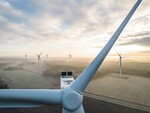News Release from Canadian Renewable Energy Association (CanREA)
Wind Industry Profile of
CanREA welcomes the release of the North American Renewable Integration Study
CanREA welcomes the release of the North American Renewable Integration Study (NARIS), the most comprehensive long-term analysis of power system evolution to date on the North American grid.
Representing some of the best intelligence available today, NARIS shows that, between now and 2050, solar energy and wind energy are poised to contribute the greatest proportion of new electricity generation to the grid—a full 90 to 95%—in both Canada and the United States.
NARIS concludes that this represents the lowest-cost pathway to the significant decarbonization and expansion of the electricity grid, while maintaining grid reliability.
As a partnership between Natural Resources Canada (NRCan), the United States Department of Energy (DOE) and Secretaría de Energía de México (SENER), NARIS aims to inform grid planners, utilities, industry, policymakers, and other stakeholders throughout North America about the possible renewable energy grid-integration scenarios on a continental basis, as well as national perspectives.
NARIS (available here: https://www.nrel.gov/analysis/naris.html) consists of a suite of models for dozens of continent-wide planning scenarios, presenting multiple pathways for grid evolution through 2050.
The National Renewable Energy Laboratory (NREL) used a supercomputer to study four possible scenarios and 38 additional sensitivity scenarios for transitioning to a low-carbon grid, defined as reaching 80% carbon reductions from the continental electric power system. For Canada, this included 80-92% reductions by 2050, compared to 2005 levels.
For each scenario, NREL modelled the transmission, demand and contribution of energy generation technologies, including the potential impacts on costs, emissions and system adequacy, taking into account variables around policy, economics and public adoption rates.
The study determined which combination of variables yielded the best possible results, with the least amount of carbon emissions by 2050 at the lowest cost. In some of these scenarios, it was assumed that electricity production would need to double to support the reduction of greenhouse gas emissions in transportation and heating.
NARIS also focused on potential cooperation between regions, and among the nations of Canada, Mexico and the US, where transmission can support the sharing of supply and the diversity of demand. There, it found that greater coordination between regions in Canada—new transmission lines—can significantly lower emissions at the lowest possible cost.
Key findings for Canada
- 90-95% of Canada’s NEW electricity generation, between now and 2050, comes from wind and solar energy.
- Renewables (hydro, wind, solar) contribute 90 to 95% of TOTAL electricity to the system annually in all scenarios, with higher integration levels driven by greater constraints on emissions and increased electrification.
- 93% decarbonization. Decarbonization in excess of 93% of Canadian generation can be achieved by 2050, through multiple pathways.
- Reliability: The future low-carbon system can balance supply and demand in a wide range of future conditions, with wind and solar contributing to planning reserves. Modeled on a 5-minute time resolution, operational flexibility is achieved through the flexible operation of all generator types.
- 78 to 150 GW of installed capacity of wind energy in 2050. Wind energy capacity is projected to range from 78 GW (in the low-cost variable generation scenario) to 150 GW (in the electrification scenario). This requires a five-to-ten-fold increase in wind energy capacity from the approximately 15 GW that was estimated by 2024 – a number we now know will be exceeded in 2022.
- 34 to 51 GW of installed capacity of solar energy in 2050. Solar energy capacity is projected to grow from an assumed value of 2 GW (a number that has already been exceeded) to 34 or 51 GW in 2050, based on the low-cost variable generation and electrification scenarios, respectively. This requires a ten-to-18 fold increase in solar energy capacity over this period.
- Of this, 7 to 32 GW of rooftop solar contributions, depending on cost and payback assumptions under the various scenarios.
- 14 GW of storage could be deployed in Canada by 2050 thanks to technology innovation in wind, solar and storage cost trajectories.
- $200 Billion USD. Regional and international cooperation can provide $200 Billion USD in net system benefits through 2050.
More may be possible
It is important to note that the base data used in this immense modelling exercise were determined at the end of 2018, when the study was commissioned, and that there have been important changes since then.
- For example, both Canada and the U.S. have now set significantly more ambitious emissions-reductions targets than what was used in the NARIS calculations, as detailed in our statement, here: https://renewablesassociation.ca/canrea-supports-canadas-new-climate-targets/ . Both countries have now made commitments to net-zero greenhouse-gas emissions by 2050. The US has indicated it wants to decarbonize the electricity grid by 2035 and Canada has said it wants to do the same before 2050. These new commitments exceed the “carbon-constrained” scenario that was aiming for a 92% reduction in GHG emissions from the electricity sector by 2050.
- Furthermore, in the years since 2018, the costs of wind, solar and energy storage have dropped further, as detailed in our blog post, here: https://renewablesassociation.ca/massive-expansion-of-wind-and-solar-energy-critical-to-ensuring-the-affordability-of-canadas-future-electricity-system/
- The study also took a conservative approach to electrification, which is generally recognized as being a key component of any strategy for Canada to achieve net zero GHG emissions by 2050.
Nevertheless, NARIS remains a groundbreaking, comprehensive and foundational study whose results provide many critical insights for the electricity sector to build on.
Next steps for CanREA
While NARIS’ modeling did not include or propose changes to electricity market and regulatory frameworks, CanREA’s position is that significant reforms will be needed to enable the best-case scenarios modelled by NARIS. Specifically:
- If Canada is to achieve net-zero greenhouse-gas emissions by 2050, it must fully decarbonize, and significantly expand, its electricity production.
- The NARIS study clearly shows that the most cost-effective way to decarbonize and expand Canada’s electricity system, while maintaining grid reliability, is to massively expand the production of wind and solar energy while investing in new transmission infrastructure that enables us to use these resources in the most efficient manner possible.
- Canada’s federal and provincial governments must work together to decarbonize our electricity grid by 2035, while recognizing the potential need for some limited flexibility mechanisms to enable the implementation of such an objective. They must also develop comprehensive electrification strategies, and enable investment in new infrastructure for transmission, distribution, energy storage and smart grid technologies, to make it possible to achieve net zero greenhouse gas emissions by 2050.
Going forward, CanREA will continue to advocate for these changes in key regions of Canada, and will advocate for the policy, regulatory and market reforms needed to achieve an expanded and decarbonized electricity grid.
- Source:
- CanREA
- Author:
- Press Office
- Link:
- renewablesassociation.ca/...
- Keywords:
- CanREA, renewable energy, Canada, North America, study, CO2, emissions, solar, wind, electricity, grid, US, decarbonization
























